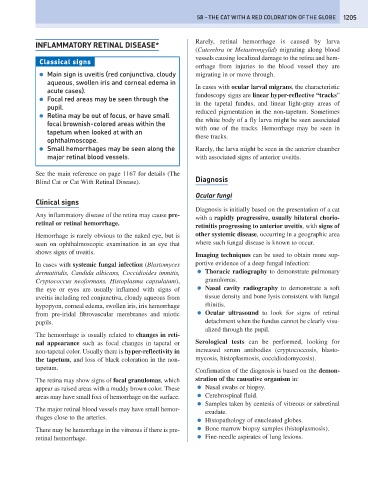Page 1213 - Problem-Based Feline Medicine
P. 1213
58 – THE CAT WITH A RED COLORATION OF THE GLOBE 1205
Rarely, retinal hemorrhage is caused by larva
INFLAMMATORY RETINAL DISEASE*
(Cuterebra or Metastrongylid) migrating along blood
vessels causing localized damage to the retina and hem-
Classical signs
orrhage from injuries to the blood vessel they are
● Main sign is uveitis (red conjunctiva, cloudy migrating in or move through.
aqueous, swollen iris and corneal edema in
In cases with ocular larval migrans, the characteristic
acute cases).
fundoscopy signs are linear hyper-reflective “tracks”
● Focal red areas may be seen through the
in the tapetal fundus, and linear light-gray areas of
pupil.
reduced pigmentation in the non-tapetum. Sometimes
● Retina may be out of focus, or have small
the white body of a fly larva might be seen associated
focal brownish-colored areas within the
with one of the tracks. Hemorrhage may be seen in
tapetum when looked at with an
these tracks.
ophthalmoscope.
● Small hemorrhages may be seen along the Rarely, the larva might be seen in the anterior chamber
major retinal blood vessels. with associated signs of anterior uveitis.
See the main reference on page 1167 for details (The
Diagnosis
Blind Cat or Cat With Retinal Disease).
Ocular fungi
Clinical signs
Diagnosis is initially based on the presentation of a cat
Any inflammatory disease of the retina may cause pre-
with a rapidly progressive, usually bilateral chorio-
retinal or retinal hemorrhage.
retinitis progressing to anterior uveitis, with signs of
Hemorrhage is rarely obvious to the naked eye, but is other systemic disease, occurring in a geographic area
seen on ophthalmoscopic examination in an eye that where such fungal disease is known to occur.
shows signs of uveitis.
Imaging techniques can be used to obtain more sup-
In cases with systemic fungal infection (Blastomyces portive evidence of a deep fungal infection:
dermatitidis, Candida albicans, Coccidioides immitis, ● Thoracic radiography to demonstrate pulmonary
Cryptococcus neoformans, Histoplasma capsulatum), granulomas.
the eye or eyes are usually inflamed with signs of ● Nasal cavity radiography to demonstrate a soft
uveitis including red conjunctiva, cloudy aqueous from tissue density and bone lysis consistent with fungal
hypopyon, corneal edema, swollen iris, iris hemorrhage rhinitis.
from pre-iridal fibrovascular membranes and miotic ● Ocular ultrasound to look for signs of retinal
pupils. detachment when the fundus cannot be clearly visu-
alized through the pupil.
The hemorrhage is usually related to changes in reti-
nal appearance such as focal changes in tapetal or Serological tests can be performed, looking for
non-tapetal color. Usually there is hyper-reflectivity in increased serum antibodies (cryptococcosis, blasto-
the tapetum, and loss of black coloration in the non- mycosis, histoplasmosis, coccidiodomycosis).
tapetum.
Confirmation of the diagnosis is based on the demon-
The retina may show signs of focal granulomas, which stration of the causative organism in:
appear as raised areas with a muddy brown color. These ● Nasal swabs or biopsy.
areas may have small foci of hemorrhage on the surface. ● Cerebrospinal fluid.
● Samples taken by centesis of vitreous or subretinal
The major retinal blood vessels may have small hemor-
exudate.
rhages close to the arteries.
● Histopathology of enucleated globes.
There may be hemorrhage in the vitreous if there is pre- ● Bone marrow biopsy samples (histoplasmosis).
retinal hemorrhage. ● Fine-needle aspirates of lung lesions.

